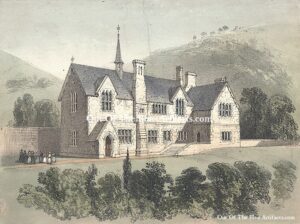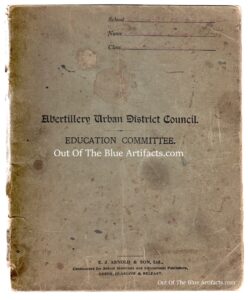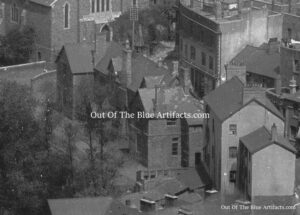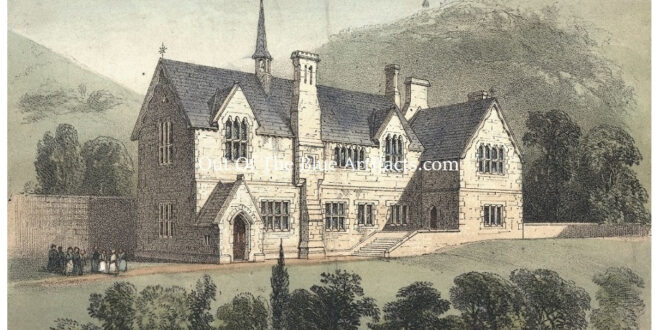The National Church of England School Abertillery.
The National School, also known as the Church School, was situated on what was to become High Street, Abertillery. Its exact spot is where the main bus-stops are today. The school was connected to St Michael’s Church and was chiefly maintained by the proprietors of the Abertillery and other works.
Abertillery in the 1830’s-40’s was practically non-existent, a few farms and one main small iron works owned by Mr Richard Walker of Trevethin, father-in-law to Mr William Webb, Brewster of Aberbeeg. His iron works were situated where Tesco’s Supermarket is today.
In the mid 1840’s Mr Walker went bankrupt and he sold the ironworks. I am not sure if Messrs Conway and Pearce purchased the old ironworks from Mr Walker at that time or a while later? Messrs Conway and Pearce later re-opened the works as a Tin Plate Manufactory and soon expanded their workings. About the same time, the Cwmtillery Collieries were in full swing along with the sinking of Penybont Colliery in 1848-1850 and the once small villages of Cwmtillery and Abertillery began to grow.
Up to this point all religious activity was centered around either Blaenau Gwent, St Illtyds in Llanhilleth or St Peters, Blaina and the people of Abertillery had to travel to attend religious services. A small group of churchgoers decided to hold services at Abertillery and they hired a room at the Royal Oak Inn (later to become the club house of Blaenau Gwent RFC, now demolished), for such purpose.
A while later a fund was set up for the purpose of building a church and school in Abertillery town. Messrs Conway and Pearce along with Messrs Brown of the Blaina Works, Messrs Price of the Penybont Colliery etc donated to the Church and School fund, to provide religious activity and education for the people of Abertillery.
On Friday 27th of August 1852, tenders were invited to build a church and schoolhouse, one advert was published though the tenders had to be sent in separately for each build. The plans of which were in the office of Mr John Conway at Abertillery and information will be given by Mr Charles Medhurst of Abertillery who will show the site of the intended buildings. The tenders had to be sent in by the 7th of September 1852, to Mr John Conway Esq. The tenders of Mr J. H. Evins of Abergavenny were accepted to build both church and school under the supervision of the Architect Mr Norton of London.
The Contractor and Architect.
The contractor was Mr J. H. Evins of Abergavenny. The architect Mr Norton of London.
Mr Joseph Hancock Evins.
Mr Joseph Hancock Evins the contractor was born in 1821 at St Georges, Glamorganshire. His wife was Mrs Sarah Evins nee Hill, born in 1815 at Sutton, Herefordshire, England. Mr J. H. Evins was also an architect and surveyor by trade.
In May 1854 St Michaels Church was the first building in the project to be erected, by the design of the Architect Mr Norton and at an estimated cost of £880. The Rev Daniel Rees Rector of Blaina was the first curate in charge.
The Official Opening of St Michael’s Church.
On Thursday 18th of May 1854, St Michaels Church was officially opened. It was noted that it had been erected by the most liberal assistance of the tin works proprietors Messrs John Conway and John Pearce and others. On the day a special train was placed upon the Western Valley’s Railway which left Newport conveying a large number of residents to take part in the opening ceremony. The service commenced at 11 o’clock and the works in the neighbourhood was stopped for the occasion.
Those present were Clergy – Lord Bishop of the Diocese; Von Archdeacon Williams of Llanvapley; Chancellor Williams of Bassaeleg; Rev Canon Jenkins of Dowlais; Rev Thomas Prothero of Malpas one of the Queens Chaplains; Rev Canon Price of Llanarth; Rev Canon Jones of Tredegar; Rev-Williams of Trinity Abergavenny; Rev Howard Williams Garth; Rev Letward Hawkins of St Woolas Newport; Rev Thomas Lavis of Trevethin; Rev Edward Lee of Bedwelty; Rev James Hughes of Llanhilleth; Rev Daniel Rees of Blaina; Rev J Morgan of Nantyglo; Rev William Evans of Usk; Rev Charles Lewis of Ebbw Val; Rev David Davies of Risca; Rev Thomas Evans of Goytre; Rev M. Phillips of Risca; Rev David Lewis of Cowbridge; Rev Jones; Rev James Price of Brecon; Rev Steele of Llanferrin; Rev John Jones of Blaenavon; Rev Griffiths of Llanelly, Breconshire; Rev Marsh of Wiltshire and numerous other clergymen whose names were not readily available.
Among the numerous visitors were – Sir Thomas Phillips; Mrs Thomas Brown Lady of the High Sheriff, and Daughters; Miss Oliphant and party; Mr John Powell Esq the High Sheriff of Brecon; Mr W. H. West Esq of Gliffaes; Mr John Price Esq of Brecon; Dr Larkins of Abertillery; Mr W. Webb Esq of Aberbeeg; Mr Thomas Prothero Price and Mr D. Price and Misses E. and M. A. Price of Brecon; Mr Edward Tucker Esq of Abersyschan; Mrs Thomas Llewelly Brewer of Blaina; Mr and Mrs Johnson; Mr and Mrs Dixon; Rev and Mrs Marsh; Mr W. Adams Williams Esq of Llangibby Castle; Mr Thomas Powell Esq and Lady of the Gaer; Mr James Brown Esq and Lady Brown of Bryn Glas; Mr John Conway Esq and Misses Conway; Mr John Pearce Esq of Abertillery; Mr Christopher James Esq of Merthyr; Mr Frederick Levick Esq of Blaina; Dr Stack of Newport; Miss Prothero of Malpas; Mr Charles Prothero Esq and Mrs Prothero of Llanvrechva Grange; Mr Henry Latch of Newport; Mr Joseph Latch Esq; Mr Thomas Phillpotts Esq of Newport; Mr Huckwell of Llandaff; Mr David Harrhy Esq and Misses Harrhy of Newport; Rev Wilcox the Weslyan Minister of Brynmawr; Mr George Gethin jun Esq of Newport; Miss Lewis and Miss Wightman of Ty-Dee; Mr T. M. Llewellyn Esq of Newport; Mr William Lane Esq of Newport; Mr William Llewellyn Esq and Mrs Llewellyn of Abercarn; Mr Hugh Williams Esq and Mrs Williams and Miss Williams of Bassaleg Rectory; Mr R. Roden Esqof Ebbw Vale; Mr and Mrs Williams of Maesyruddyd; Mr John Jayne Esq of Nantyglo; Mr William Morgan Esq and party of Abergavenny; Mr John Jones Esq and party of Bristol; Mr James Woodfield Esq; Mr Thorne of Newport and Mr Ford and party of Brynmawr:
The usual formularies of consecration were commenced by the bishop at the entrance of the church aided by Messrs Conway and Pearce and thirty-two other dignitaries of the church, they proceeded to the altar where prayers were read. Later Rev Daniel Rees, Curate, read the service for the day after which Sir Thomas Phillips and Mr James Brown made a collection which amounted to £50. Later the party was treated to lunch by Mr Hallen of the Westgate Hotel Newport, where he provided a cold collation in a superior style of over seventy various dishes spread under a large marquee which was erected in the grounds and provided by Mr Pearce from the stores of Mr Francis of Llanelly.
The Laying of the Foundation Stones of the Church School.
After the meal the chief party accompanied the Mayor of Newport Mr James Brown to a piece of ground a little further down the valley where the church schools were to be erected. Here, after all the preliminaries were arranged, the foundation stone of the new schools was laid by Mr James Brown.
The trowel with which he laid the first stone was an elegant piece of work in silver, bearing the following inscription – “Industria et Probitate” the arms of Mr Brown. The silver trowel was presented to Mr Brown the Mayor of Newport by his friend Mr John Pearce of Lydbrook on the occasion of his laying the foundation stone of the Church of England Schools, Abertillery Monmouthshire. “May 18th 1854” After the stone had been properly adjusted by the Builder Mr J. H. Evins of Abergavenny and the Architect Mr Norton the ceremony was fully carried out by Mr Brown who concluded his duty by a series of raps on the surface of the block with an ebony hammer after which he delivered an excellent address in which he read a few telegraphic dispatches from the scene of the Eastern War.
Mr James Brown was the son of Mr Richard Brown of the Ebbw Vale Iron Works and brother of Mr Thomas Brown the manager of the Blaina & Cwmcelyn Iron Works and founder and owner of the Cwmtillery Colliery 1842-1847.
After the church was erected the provision for the donations for the school could be started from the services held and it wasn’t long before the school was erected and furnished.
 The official Opening of The National Church Schools.
The official Opening of The National Church Schools.
The National School (as seen left) opened on Tuesday 1st of January 1856. Records show that the school had an infant’s room on the lower level 34′ feet by 18′ feet with a house for teachers attached. On the upper level there was a large classroom for mixed classes 55′ feet by 18′ feet and a classroom 19′ feet by 18′ feet.
The Contractor and Architect.
Mr J. H. Evins was the constructor. Mr Norton was the architect. The Church School was built at an estimated cost of £1,200. Seen (left) is an artist’s impression of the National School, Abertillery. Even though the design looks grand, fanciful and picturesque, the representation of the school in the image is fairly accurate and it shows the front of the Church School facing the British School across the valley. The trees in the foreground would now be on the path leading down to the Abertillery Library from the main bus stops. The back of the building abutted High Street.
Abertillery Reading Room.
In the 1850’s Sir Thomas Phillips and Messrs T. P. and D. Price opened a reading room in rented premises in Abertillery town close to where the Arcade is today. Later they moved and opened a new reading room and library at the Church School, Abertillery, they were helped by Mr James Brown and Mr Conway, they acquired a room and filled it with books and periodicals of the day in English and Welsh. Their aim was to educate the population and encourage the Welsh language.
Sir Thomas Phillips.
Sir Thomas Phillips was born in 1801 at Llanelly, Brecknockshire and was the Mayor of Newport during the Chartists Riots, while attempting to peacefully negotiate with the movement he was shot in the arm. He was later awarded a Knighthood for his services to Newport throughout that volatile time.
Messrs T. P. & D. Price.
Mr Thomas Prothero Price and his brother David Price were bankers and merchants from Brecon who were the original founders and owners of the Penybont Tillery Colliery 1848-1864.
The First School Inspection.
On Wednesday 12th of August 1857, there was an inspection at the school conducted by Sir Thomas Phillips; Rev D. Morgan of the parish; Rev J. R. Jones; Rev W. Price vicar of Llanarth; Mr Medhurst and Mr Price: Mr Stammers, the organising master of the diocese conducted the examination. There were 120 boys and girls being educated at the school and it stated that the school was chiefly maintained by the proprietors of the Abertillery and other works.
Past Headmasters and Headmistresses at the National Church of England School Abertillery.
The following is a list of past headmasters and headmistresses who were at the Church School, Abertillery who were mentioned in news reports and directories.
Mr James D. King and Mrs Sarah King.
In 1859 the South Wales Directory has Mr James D. King as being the headmaster and his wife Mrs Sarah King as mistress at the National Church of England School Abertillery. In an earlier report the couple were there in that role as early as 1857. The date seems to suggest they were the first master and mistress.
Mr William Hudson and Mrs Charlotte Hudson.
In 1861 the South Wales Directory has Mr William Hudson as being the headmaster and his wife Mrs Charlotte Hudson as mistress at the National Church of England School Abertillery. Mr Hudson was born in 1836 at Stepney, Middlesex and Mrs Hudson was born in 1839 at Bilton, Gloucester. The census shows the couple lived at the school.
Mr John Poyntz Owen and Miss Eleanor Owen.
In 1871 the Monmouthshire Directory has Mr John Poyntz Owen as being the headmaster and his sister Miss Eleanor Owen as mistress at the National Church of England School Abertillery. The 1871 census states – Mr Owen was born in 1846 at Fishguard, Pembrokeshire and Miss Owen was born in 1843 also at Fishguard. Mr Alfred William Owen was also listed as living at the school and was a member of the teaching staff. Mr Alfred William Owen was a brother to the headmaster and mistress. The family lived at the school. In 1879 Mr Owen left for a similar post at Brockham Green Schools, Betchworth, Surrey.
Mr Thomas Baker and Mrs Mary Baker.
In 1880 the Monmouthshire Directory has Mr Thomas Baker as being the headmaster at the National Church of England School Abertillery. It is believed that his wife Mrs Mary A. Baker was the mistress though not listed. The 1881 census states – Mr Baker was born in 1851 at Weymouth, Dorset and Mrs Baker was born in 1849 at Tredegar, Monmouthshire. The family lived at Portland House, Abertillery. In 1891 Kelly’s Directory as Mr John T. Baker as master and Mrs Baker as the infant’s mistress.
Miss Emma Jane Seeley.
At some point Mrs Emma Jane Seeley became headmistress at the National School, Abertillery.
Mr J. Vickery.
In 1901 the National Newspapers has Mr J. Vickery as the headmaster at the National Church of England School Abertillery. There is not a great deal of information on Mr Vickery apart from the fact that he left the school in 1901 to teach at Reading, Berkshire. At this time Mr C. W. Dawe was the assistant headmaster at the Church School, Abertillery.
Mr Walter Waters and Miss May Briggs.
In 1914 the Kelly’s Directory has Mr Walter Waters as being the headmaster and Miss May Briggs as mistress of the infants at the National Church of England School Abertillery. Mr Walter Waters was married to Mrs Kate Waters, he had become the headmaster at the school in 1902. The 1911 census states – Mr Waters was born in 1873 at Worcester and Mrs Waters was born in 1873 at Neath, Glamorgan. The family lived at Belmont House, 139 Gladstone Street, Abertillery. The 1920 Kelly’s Directory lists Mr Waters as still being the headmaster at the school.
Capt. Walter David Jones.
In 1939 Capt. Walter David Jones became headmaster at the National Church of England School Abertillery. Capt. W. D. Jones was born in 1897 at Llandyssul, Cardiganshire. He served on the Salonika Front during WWI and was appointed to the staff at the school in 1920 and became the headmaster in 1939. Capt. Jones was a member of the Reserves of Officers and was called up in 1940 as a Welsh interpreter in France. After Dunkirk he served in the Intelligence Department until his discharge owing to ill health in 1943. Capt. W. D. Jones died in 1945 while living at Hollybrook, Rose Heyworth Road, Abertillery.
Mr M. M. Evans.
In 1945 Mr M. M. Evans was the headmaster at the National Church of England School Abertillery.
Miss Sarah D. Daniel.
In the late 1940’s Miss Sarah D. Daniel was the last headmistress at the National Church of England School Abertillery. When the school closed Miss Daniel took a similar post as headmistress at the Glendower Infants School at Monmouth.
 An Abertillery Urban District Council Education Committee Textbook.
An Abertillery Urban District Council Education Committee Textbook.
This is a 1930 Abertillery Urban District Council Education Committee textbook which came from the Church School, Abertillery. The book belonged to Miss Frances Trigg of Class 1 Standard 6. who lived with her parents at Bridge Street, Abertillery. Miss Frances (Nan) Trigg, nicknamed “Nan” by members of her family, was my wife’s grandmother’s sister. Sadly, Miss Francis (Nan) Trigg died in September 1931 at just 13 years of age, just a short while after she completed the textbook.
Plans to Close the National Church School.
In June 1948 the closure of the National Church School was discussed although put off until a later date. In August 1948 the Primary Education Sub-Committee of the Monmouthshire Education Committee recommended the closure of the school as soon as possible. The reason was stated as a decrease in the number of pupils and the state of the building being below the requirements of the Ministry’s building regulations.
The Children of Australia and the Church of England School, Abertillery.
On Friday 6th of January 1950, the South Wales Echo reported – Christmas 1949, forty children attending the Church School, Abertillery each received a large bag of sweets sent to them by pupils of Fort Street High School, Sydney, Australia. The girls from down-under had adopted the school at Abertillery in the 1940’s and since then had sent parcels of sweets each Christmas. Miss Sarah D. Daniel, headmistress and Miss A. M. Taylor a teacher handed then out to the children.
The Closure of the National Church School.
The National Church School closed in March 1950. Alderman John Snellgrove reported to the Abertillery Trades Council that the Bishop of Monmouth approved the top portion of the Church School, Abertillery to be used as a library. The vicar Rev Owen Davies of Abertillery agreed with the plan.
 The Official Opening of the Abertillery Public Library.
The Official Opening of the Abertillery Public Library.
On Tuesday 22nd of July 1952, the Abertillery Public Library at the old National Church School building was officially opened. The library was opened by County Councillor Hubert Jones of Rogerstone, (Chairman of the County Library Sub-Committee). Mr Jones was supported by Councillor W. H. Hillman (Chairman of the Abertillery Council); Councillor W. E. J. Derrick (Chairman of the Divisional Education Executive); Mr D. Watson (Deputy Director of the Education for Monmouthshire); Mr E. D. Pollard (County Librarian); Mr Rees Rees (Divisional Education Officer) and other representatives of public life:
The Librarian.
Miss Dorothy Morgan B.A., an old Tyleryan was chosen as the town’s librarian, Miss Morgan was aided by an assistant and two cleaners.
It was stated in the report that there were 10,000 books in the library, and that thousands of people, young and old have the opportunity of acquiring knowledge which has hitherto been denied them.
Facts and Figures.
In the first month the library registered 4,129 members – of that number 2,949 were adults and 1,180 were juveniles. The average daily take out figures were 800 books per day.
During the first nine-months ending 31st of December 1952, more books were distributed from the Abertillery Public Library than from any other of the county council’s branch libraries. It was revealed in the county librarian’s report that 92,807 books were issued from the Abertillery Public Library. The librarian Miss Morgan told the South Wales Gazette that two-thirds of the books taken out were fiction, the current favourite was Alistair Maclean’s “H.M.S. Ulysses”. Other novels in demand were – Neville Shute’s “Requiem for a Wren” and Morton Thompson’s “Not as a Stranger”. Biographies were the next most sought after with – Paul Brickhill’s “Reach for the Sky” the story of Douglas Bader with the most popular book in the travel section being “The Kon Tiki Expedition”.
The Closure of the Library.
On Saturday 7th of November 1970, the library closed.
The New Library.
In the late 1960’s, early 1970’s, a new Abertillery Public Library was planned. It was built on special county council land just off Oak Street between the Bush Hotel and the Abertillery Fire Station, on the site of the old railway sidings. The new library was opened on Thursday 12th of November 1970 and the old library at High Street re-located to the new building.
The Scala Cinema.
In about 1974 the old library on High Street was transformed into a cinema and named the Scala Cinema. The Scala was set up with old equipment from other cinemas, it was owned and operated by Mr D. Lyn Thomas.
The Closure of the Scala Cinema.
The Scala Cinema closed in August 1977 and was later demolished along with the Globe Hotel just a little further south in preparation for the new one-way street traffic system through town which was completed in about 1983. The main bus stops for Abertillery now occupies its site.
 Out Of The Blue Artifacts A Library of a lifetime of collecting
Out Of The Blue Artifacts A Library of a lifetime of collecting
